The modal verb galėti ʻcan/could/may/mightʼ in academic Lithuanian: distribution, frequency and semantic properties
The modal verb galėti ʻcan/could/may/mightʼ in academic Lithuanian: distribution, frequency and semantic properties
Author(s): Jolanta ŠinkūnienėSubject(s): Syntax, Lexis, Semantics, Pragmatics, Baltic Languages
Published by: Vilniaus Universiteto Leidykla
Keywords: modality; academic discourse; corpus-based analysis; cross-disciplinary analysis; modal verbs;
Summary/Abstract: The aim of the present paper is to investigate the frequency and distribution patterns as well as the spectrum of modal meanings conveyed by the Lithuanian modal verb of possibility galėti ‘can/could/may/might’ in academic Lithuanian. The study is based on Corpus Academicum Lithuanicum (www.coralit.lt), a specialized synchronic corpus of written academic Lithuanian (roughly 9 million words). In order to allow a disciplinary comparison, the paper analyses the use of this modal verb in academic texts from three science fields: the humanities, the biomedical sciences and the technological sciences. Quantitative and qualitative approaches are employed alongside corpus-based analysis to reveal the ways in which this modal verb of possibility is used in academic language. The first part of the paper investigates the frequency patterns of various forms of galėti ‘can/could/may/might’ in the three science fields. The second part looks at the variety of meanings this modal verb can convey in Lithuanian specialised language. The results show that there is a fairly similar distribution of this modal verb across different science fields. In terms of its semantic functional capacities, galėti ‘can/could/may/might’ is used to convey all three types of modality (epistemic, deontic and dynamic), however, the most frequent use in Lithuanian academic discourse seems to be that of dynamic modality.
Journal: Kalbotyra
- Issue Year: 2016
- Issue No: 69
- Page Range: 205-222
- Page Count: 18
- Language: English

